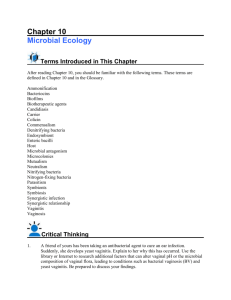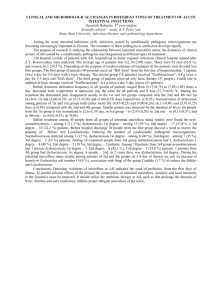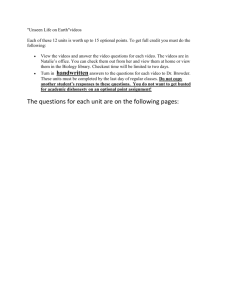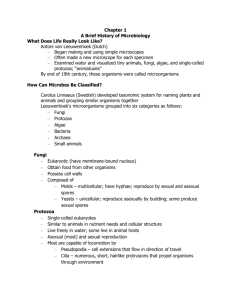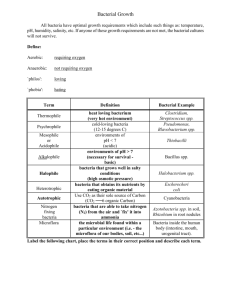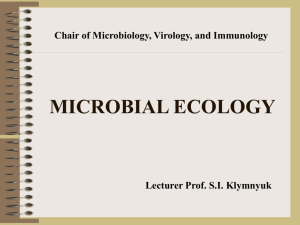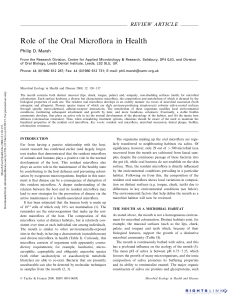Chapter 10. Microbial Ecology and Microbial Biotechnology
advertisement
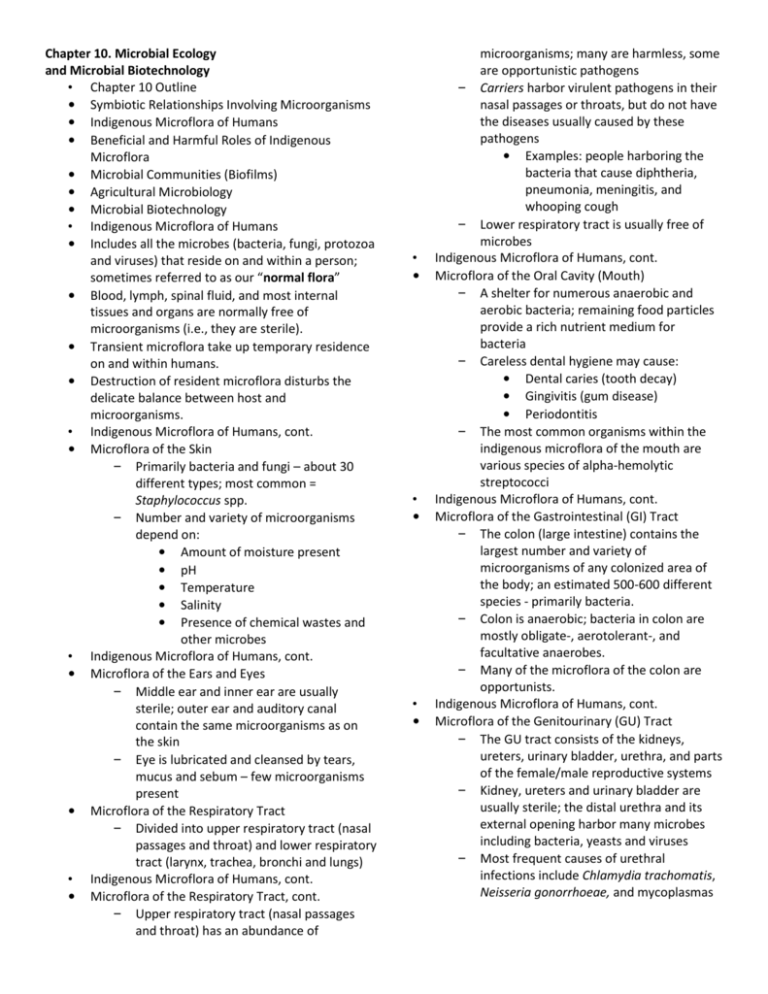
Chapter 10. Microbial Ecology and Microbial Biotechnology • Chapter 10 Outline • Symbiotic Relationships Involving Microorganisms • Indigenous Microflora of Humans • Beneficial and Harmful Roles of Indigenous Microflora • Microbial Communities (Biofilms) • Agricultural Microbiology • Microbial Biotechnology • Indigenous Microflora of Humans • Includes all the microbes (bacteria, fungi, protozoa and viruses) that reside on and within a person; sometimes referred to as our “normal flora” • Blood, lymph, spinal fluid, and most internal tissues and organs are normally free of microorganisms (i.e., they are sterile). • Transient microflora take up temporary residence on and within humans. • Destruction of resident microflora disturbs the delicate balance between host and microorganisms. • Indigenous Microflora of Humans, cont. • Microflora of the Skin – Primarily bacteria and fungi – about 30 different types; most common = Staphylococcus spp. – Number and variety of microorganisms depend on: • Amount of moisture present • pH • Temperature • Salinity • Presence of chemical wastes and other microbes • Indigenous Microflora of Humans, cont. • Microflora of the Ears and Eyes – Middle ear and inner ear are usually sterile; outer ear and auditory canal contain the same microorganisms as on the skin – Eye is lubricated and cleansed by tears, mucus and sebum – few microorganisms present • Microflora of the Respiratory Tract – Divided into upper respiratory tract (nasal passages and throat) and lower respiratory tract (larynx, trachea, bronchi and lungs) • Indigenous Microflora of Humans, cont. • Microflora of the Respiratory Tract, cont. – Upper respiratory tract (nasal passages and throat) has an abundance of • • • • • • microorganisms; many are harmless, some are opportunistic pathogens – Carriers harbor virulent pathogens in their nasal passages or throats, but do not have the diseases usually caused by these pathogens • Examples: people harboring the bacteria that cause diphtheria, pneumonia, meningitis, and whooping cough – Lower respiratory tract is usually free of microbes Indigenous Microflora of Humans, cont. Microflora of the Oral Cavity (Mouth) – A shelter for numerous anaerobic and aerobic bacteria; remaining food particles provide a rich nutrient medium for bacteria – Careless dental hygiene may cause: • Dental caries (tooth decay) • Gingivitis (gum disease) • Periodontitis – The most common organisms within the indigenous microflora of the mouth are various species of alpha-hemolytic streptococci Indigenous Microflora of Humans, cont. Microflora of the Gastrointestinal (GI) Tract – The colon (large intestine) contains the largest number and variety of microorganisms of any colonized area of the body; an estimated 500-600 different species - primarily bacteria. – Colon is anaerobic; bacteria in colon are mostly obligate-, aerotolerant-, and facultative anaerobes. – Many of the microflora of the colon are opportunists. Indigenous Microflora of Humans, cont. Microflora of the Genitourinary (GU) Tract – The GU tract consists of the kidneys, ureters, urinary bladder, urethra, and parts of the female/male reproductive systems – Kidney, ureters and urinary bladder are usually sterile; the distal urethra and its external opening harbor many microbes including bacteria, yeasts and viruses – Most frequent causes of urethral infections include Chlamydia trachomatis, Neisseria gonorrhoeae, and mycoplasmas – The male and female reproductive systems are usually sterile, with the exception of the vagina Beneficial and Harmful Roles of Indigenous Microflora • Humans derive many benefits from their indigenous microflora; examples - vitamins K and B12. • Microbial Antagonism – Means “microbes versus microbes” – Many members of our indigenous microflora are beneficial in that they prevent other microbes from becoming established – Other examples of microbial antagonism involve: • Production of antibiotics and bacteriocins (antibacterial proteins); an example is colicin, produced by E. coli Beneficial and Harmful Roles of Indigenous Microflora, cont. • Opportunistic Pathogens and Biotherapeutic Agents – Opportunistic pathogens are those microorganisms that “hang around,” waiting for the opportunity to cause infection • Examples: E. coli, other members of the family Enterobacteriaceae, S. aureus, and Enterococcus spp. – The delicate balance of the indigenous microflora can be upset by antibiotics, other types of chemotherapy, and changes in pH – Bacteria and yeasts used to stabilize the microbial balance are called biotherapeutic agents or probiotics Microbial Communities • It is rare to find an ecologic niche in which only one type of microorganism is causing a particular effect • Microorganisms are often organized into biofilms – complex communities of assorted organisms. Biofilms are everywhere; example – dental plaque. • Biofilms consist of a variety of different species of bacteria plus a gooey polysaccharide that the bacteria secrete; the bacteria grow in tiny clusters called microcolonies, separated by water channels • Biofilms have medical significance; they form on urinary catheters and medical equipment and can cause diseases like endocarditis Microbial Communities, cont. • Microbes commonly associated with biofilms on medical devices include the yeast, Candida albicans, and bacteria like Staphylococcus aureus, Enterococcus spp., Klebsiella pneumoniae, and Pseudomonas aeruginosa. • Biofilms are very resistant to antibiotics and disinfectants – Antibiotics that are effective against pure cultures of organisms have been found to be ineffective against those same organisms within an actual biofilm • Bacteria in biofilms produce different types of proteins that may not be produced by the bacteria in pure culture. Synergistic Infections • When 2 or more organisms “team up” to produce a disease that neither could cause by itself • The diseases are called synergistic infections, polymicrobial infections, or mixed infections – Examples: • Acute necrotizing ulcerative gingivitis (ANUG, trench mouth, or Vincent’s disease). • Bacterial vaginosis (BV) Agricultural Microbiology • There are many uses for microorganisms in agriculture • Role of Microbes in Elemental Cycles – Microorganisms play an important role in the cycling of nutrients and elements like nitrogen, carbon, oxygen, sulfur, and phosphorus. • N2 is converted by nitrogen-fixing bacteria and cyanobacteria into ammonia (NH3) and ammonium ion (NH4). Agricultural Microbiology, cont. • Other Soil Microorganisms – There are a multitude of other microorganisms in soil – bacteria, fungi, algae, protozoa, viruses, and viroids; many are decomposers. – A variety of human pathogens live in soil including Clostridium spp. (such as C. tetani and C. botulinum) and the spores of Bacillus anthracis. Biotechnology • Defined as “any technological application that uses biological systems, living organisms, or derivatives thereof, to make or modify products or processes for specific use” • • • Microbes are used in a variety of industries, including the production of certain foods and beverages, food additives, vaccines, and antibiotics. Microbes are used in the production of foods like bread, cheeses, olives, pickles, vinegar and yogurt, as well as in the production of alcoholic beverages like beer and wine. Many antibiotics and drugs are produced in pharmaceutical companies by fungi and bacteria (penicillin for example).
